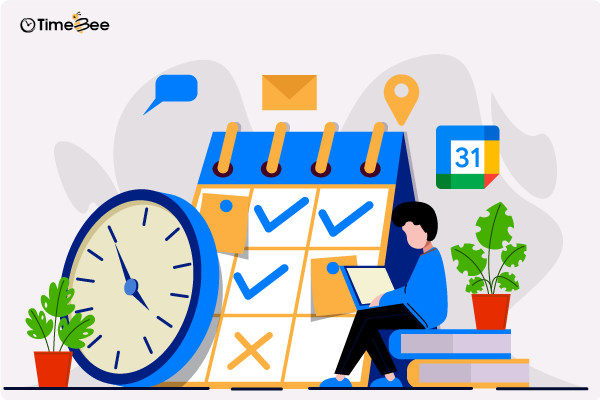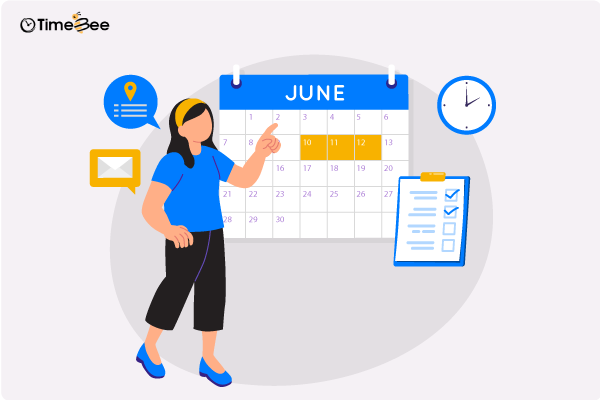Content
Content
During a typical workday, you must perform activities or tasks to achieve your productivity goals and keep things moving. After all, maintaining a certain level of productivity is essential for achieving a profitable outcome.
However, if you’re in a management or supervisory role, you must take on several responsibilities to ensure you and your employees are heading in the right direction. This means that task switching does become inevitable, which can hinder progress.
Indeed, task switching in a nonstructured way becomes a major productivity problem. The continuous back-and-forth between activities is called ‘context switching’ and can destroy your productivity immediately.
Let’s dive deeper into how it can affect your output.
What is Context Switching?
Context switching refers to shifting attention between tasks or projects when not needed or without completing the activity you are doing at the moment. Usually, when the switch happens, it derails you from a thought process, and you lose focus.
While working in an office or working from home, you must complete certain major tasks and others that supplement them. These include meetings, emails, monitoring tasks, and extensive communication.
But minor distractions, like a social media notification can disrupt your flow. To respond to this notification, you stop doing your work and start answering that message, which may lead to a conversation that completely stonewalls what you were previously doing.
When you eventually do get back to your task, you will find that you’re much less productive.
What Causes Context Switching?
Context Switching does not happen intentionally. It is generally caused by mismanagement and psychological issues. It is fixable, but first, you must understand its underlying causes.
Multitasking
Context switching is often confused with multitasking, but there’s a fundamental difference. Multitasking involves completing numerous tasks simultaneously, while context switching involves shifting focus completely between work activities.
One may argue that multitasking is a semblance of efficiency; however, in reality, it is one of the significant causes of unproductivity. Research shows that 97.5% of people can’t multitask effectively.
The reason is that, logically, your mind focuses on a point per second, so you are doing only one task at a time. So, if you attend a call while typing an email, you concentrate on what to write or say. So, sometimes you believe you are multitasking, but you have already transitioned to context switching.
Work Mismanagement
Work Mismanagement is planning your daily work without any research or reasoning. If your daily tasks lack structure and clarity, you are prone to context switching.
For example, you know your daily work requires meetings and communication, but you have not made your schedule more flexible to accommodate unforeseen tasks. So when you leave for a meeting without wrapping up what you were doing, you lose focus entirely.
Poor Time Management
Similar to work mismanagement, mismanaged time also leads to you taking on many responsibilities all at once. When you juggle your tasks without a clear plan or schedule, you lose focus.
Time Mismanagement includes careless allocation of time to tasks, making a tight schedule that is not flexible, or assigning time-based on assumptions rather than using concrete data. In all these scenarios, you end up with more work and keep switching between tasks to meet deadlines.
In addition, when you take on too many responsibilities, disregarding your time, you try to complete them together and end up with context-switching.
Short Attention Span
Shot attention span is the inability to stay focused on one task longer. Individuals with short attention spans keep switching between tasks, leading to context switching. Sometimes, it is not a cognitive issue; it can be boredom, lack of interest, work overload, or distractions.
Maintaining focus is essential to completing tasks on time. If you are constantly distracted, you will experience frequent shifts in attention. You will always need more time to meet deadlines, leading to work pileups and context switching.
How Does Context Switching Destroy Productivity?
Context switching is often considered a productivity killer and happens for various reasons. Understanding these causes can help individuals and organizations to formulate and implement strategies to reduce context switching effectively. Here are some common causes of context switching:
Efficiency Reduction
Efficiency requires you to complete your tasks on time without compromising quality. Constantly jumping from one task to another without finishing it will confuse and disrupt your workflow. It is natural for your brain to take time to reorient itself and get back to the task at hand, resulting in decreased overall output.
The brain’s reorientation also results in impaired decision-making. Making informed choices or prioritizing effectively becomes challenging with a cluttered frame of mind. You are unable to decide which task to complete first, which leads to subpar outcomes.
Increased Errors
Context switching also leads to an increase in errors and mistakes. When your attention is divided between multiple tasks, you overlook important details and end up making careless mistakes.
Your mistakes may result in work stress and an increased workload as you redo your tasks. In addition, you will have to leave your current activity and focus on the work you have already done, compromising your daily performance.
Cognitive Health
Maintaining physical and mental health is the only way to stay productive at work. If your efficiency is reduced, you make mistakes, and you have an excessive workload, your attention will be constantly divided. You will have a thousand things on your mind, including the pressure to be good at work.
To keep up with competing demands, you constantly juggle tasks, increasing pressure and stress levels. When the stress levels are high, you won’t be able to maintain the balance that makes you productive.
Measures to Prevent Context Switching
Once you are familiar with the causes and their impact, it becomes easier to identify and implement preventative measures to reduce context switching. Here are a few to get you started.
Identify Context Switching Patterns
To eliminate context switching from your work, first, you need to identify what is causing it. Everyone has a different trigger, and to deal with it, you need to pinpoint the triggers and patterns of context switching in your work routine.
You can note them down manually or use productivity tracking tools to monitor your workflow and pinpoint areas where context switching occurs most frequently.
Prioritize Tasks
Prioritizing tasks is the best way to reduce context switching. If you know what matters most for your work, you will finish it first and move your attention to other tasks when necessary.
Establish clear priorities and focus on high-impact tasks that align with your goals and objectives. Use techniques and methods of prioritization to avoid confusion and stay on track.
By prioritizing tasks based on their importance and urgency, you can minimize the need for unnecessary context switches. Moreover, you channel your energy toward activities that can help you improve performance.
Time Blocking
Time Blocking means dedicating blocks of time to specific tasks or projects. This technique assists you in focusing on the task at hand and avoiding distractions.
With time blocking, you will have a structure that shows you the times you cannot divert your focus. Once you know your focused work sessions, you can create an environment conducive to concentrating on quality work.
Want to Say Goodbye to Distractions?
Use TimeBee to Improve Focus
Avoid Multitasking
As mentioned before, multitasking causes context switching. To maintain productivity, you need to resist the temptation to multitask. You can avoid multitasking by practicing the following methods.
- Identify your multitasking habits
- Maintain a work journal
- Focus on single-task
- Ignore distractions
- Follow your prioritization
- Stay organized at work
Applying these techniques allows you to streamline your work activities and maximize productivity.
Batch Similar Tasks
Batching similar tasks together can help minimize context switching by allowing you to focus on a specific activity. For instance, if you have to reply to many emails that don’t require your immediate attention, you can answer them later rather than stop your current work and answer them right away.
This grouping allows you to streamline your workflow and reduce distractions. So you can follow your schedule strictly and avoid context-switching.
Take Breaks
Incorporating regular breaks allows you to declutter your mind and offers clarity to strategize your work routine. Changes and interruptions are inevitable, but you can rearrange a few things with a clear mind and concentrate on what is more important.
Go for a short walk, do a brief meditation session, or simply step away from your desk to recharge and rejuvenate your mind. These breaks will help alleviate mental fatigue and enhance productivity.
Using Apps and Tools to Prevent Context Switching – TimeBee
Context switching happens when there is a lack of system and organization. A tool to manage your time and productivity can be extremely helpful when shifting between responsibilities is inevitable.
It allows you to identify how often you switch between tasks and how much time you spend on each. This data can streamline workflows and ensure that you’re focused on a few important responsibilities.
TimeBee is a tool that tracks time against tasks and can help pinpoint task time distribution. It offers productivity reports and improves daily task management.
Here’s how you can use it to conquer context switching:
Track your Time Against Prioritized Tasks
In TimeBee, you can track time against each task. This feature helps you concentrate on that task. If you need to switch, start the timer for the other task to be aware of the switch. Furthermore, it helps you reduce multitasking.
TimeBee’s time tracking also helps with time blocking. You can note the accurate time you spent on a task and use the historical data for future time blocking.
Track your Productivity
TimeBee also helps measure your productivity throughout the day. By tracking your working habits, it provides graphical representations and reports that provide valuable insights into your work habits and performance over time.
Along with the productive habits, these insights also include the ratio of breaks you take during your work.
With this data, you can identify how productivity issues occurred and whether or not context switching was one of them.
Track Work Progress
The TimeBee desktop app is constantly taking screenshots of your work and uploading them to the dashboard for you to view.
Not only does this create a visual record of your work, but it also helps you return to your main activity when you do have to juggle multiple tasks. By analyzing the screenshots through the timeline view in TimeBee, you can recover your train of thought and regain focus for your original tasks.
However, a visual record of your work can also help you understand where your productivity starts to drop and why you might feel it necessary to switch between tasks.
Conclusion
In conclusion, context switching can be one reason you are not productive at work. You must identify the causes and impacts of context switching to eliminate it entirely from your work.
Once you know how it affects your performance, you can choose preventive measures to help you control it.
Furthermore, a tool like TimeBee that hinders you from switching between apps can be useful. With all these techniques and tools, you can undoubtedly break free from content switching and excel in your work productivity.
Unlock Your Productivity Potential!
Get TimeBee Today
Similar Reading



